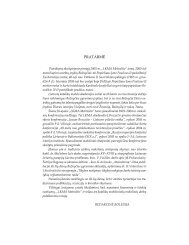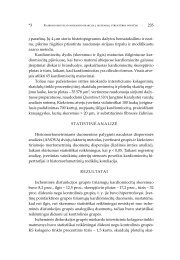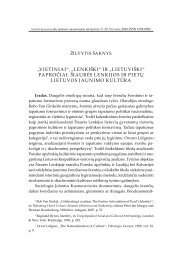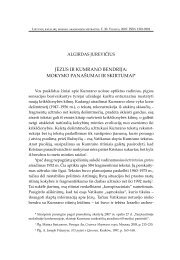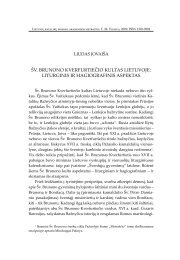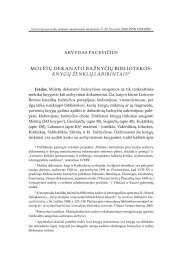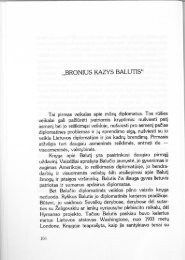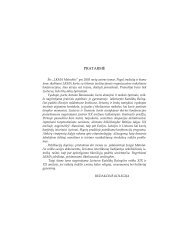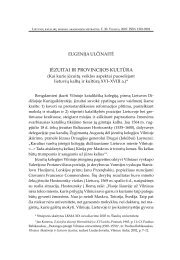alvito dekanato parapijos xvii a. antroje pusėje - Lietuvių katalikų ...
alvito dekanato parapijos xvii a. antroje pusėje - Lietuvių katalikų ...
alvito dekanato parapijos xvii a. antroje pusėje - Lietuvių katalikų ...
Create successful ePaper yourself
Turn your PDF publications into a flip-book with our unique Google optimized e-Paper software.
*25<br />
Alvito <strong>dekanato</strong> <strong>parapijos</strong> <strong>xvii</strong> a. <strong>antroje</strong> <strong>pusėje</strong><br />
THE PARISHES OF THE ALVITAS DEANERy<br />
IN THE SECOND HALF OF THE 17TH C.<br />
Vaida Kamuntavičienė<br />
summary<br />
Based on the materials of the visitations to the Alvitas deanery in 1668, 1674<br />
and 1700 and the founding privileges of the churches, the article reveals the situation<br />
of the Catholic Church parishes in the Alvitas deanery of the Vilnius diocese<br />
in the second half of the 17th c., after the war with Russia (and sweden) in<br />
1654–1667 and the first occupation in the history of the Grand Duchy of Lithuania<br />
(GDL).<br />
Research showed that the first parishes in this wooded region began to be<br />
created only at the beginning of the 16th c. The chronological order of the granting<br />
of the foundation privileges was the following: Bakalariava (about 1520),<br />
Janauka (about 1556), Račkai (about 1558), Vištytis (about 1566), Prieraslis (1571),<br />
Pilypavas (1571), Pajevonis (1589), Gražiškiai (1596), Lankeliškiai (1609), Alvitas<br />
(1617), Vilkaviškis (1623), Vižainis (1652), Bartninkai (1663). Because the deanery<br />
was being founded in the lands of the King of Poland and the Grand Duke of<br />
Lithuania, it played an important role in forming and strengthening the churches<br />
in this region.<br />
As the region had sufficient quality wood, it was chosen as the main construction<br />
material for the churches. All the churches of the deanery are wooden except<br />
for the brick in the Prussian manner church of Račkai. According to the data of<br />
1674, the most beautiful of the wooden churches in the deanery was the parish<br />
church of Janauka. In 1668 all of the churches without exceptions had three altars,<br />
while in 1700 the number of altars in some churches increased up to five and<br />
chapels appeared.<br />
In 1668 a shortage of priests was felt in the deanery. Violating the Trent requirements<br />
three clergymen ruled two parishes without having a helper – a vicar.<br />
In 1700 the situation was considerably better, every parish had its pastor and some<br />
of them also supported vicars. There was a concern that the pastor would know<br />
the language of the local population (Lithuanian), would adhere to the regulations<br />
of the Council of Trent for pastoral ministry, would perform the required number<br />
of masses, would not administer the sacraments or offer masses in public places,<br />
in private estates, etc. In the parishes the worship of the Blessed Virgin Mary was<br />
popular with the singing of the Rosary and the Hours of the Blessed Virgin Mary.<br />
In the deanery three paintings of the Blessed Virgin Mary were mentioned as<br />
miraculous. In 1668 the Saint Anne Church Brotherhood was active in Alvitas, in<br />
Pilypavas and Prieraslis after the wars the Guardian Angel Brotherhood restored<br />
35



